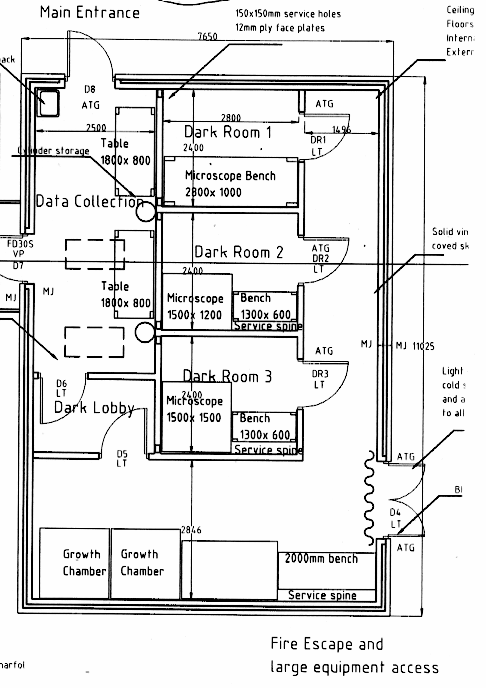|


| |
Warwick Imaging Facility
Specific design considerations
 | Each imaging workstation must be maintained in "real" darkness and at
constant, controlled temperature |
 | Personnel access in darkness to avoid disturbing ongoing experiments |
 | Adjacent office area for analysis computers, as close as possible to the cameras to
allow easy access for liquid nitrogen, power and data cables |
 | Incubators and laminar flow hood to maintain and manipulate biological samples, usually
outside the imaging room to avoid light and heat leakage |
 | Each circadian rhythm experiment can necessitate a week of continuous imaging |
 | Plant samples can be exquisitely sensitive to light |
Plan (mm)

Notes
 | Large bench in dark room 1 can house a complete imaging system, including computers. |
 | Data collection area houses all other computers, printer and liquid nitrogen tanks; two
skylights for natural light |
 | One microscope each in dark rooms 1, 2 and 3; there is sufficient space for ancillary
equipment (e.g. macro imaging chamber) in each room |
 | Two service holes per inner dark room provide cable access |
 | Access route minimises light exposure of inner dark rooms, even when their doors or
illuminated incubator doors are opened |
 | Large rear door allows easy equipment access but requires careful light-proofing |
 | Each room has independent temperature control (+/- 1C in inner dark rooms), with
temperature alarm in data collection room |
 | Ventilation must be sufficient to cope with liquid nitrogen venting |
 | All internal walls except data collection painted matt black; floor is light coloured to
aid navigation |
 | All doors fitted with rubber and/or brush seals to aid light-proofing |
 | Strip lighting for maintenance with switches at head height |
 | Green ambient safe lighting on pull switches, from filter-wrapped low-power fluorescent
lights (sold as wardrobe lights) at ceiling level |
 | Work surface lighting from filtered low-power bulbs in desk lamp housings |
Design team:
Andrew Millar, Dennis Jones, Bob Chamberlain, Paul Goode (Biol. Sci.)
Steve Walker and colleagues (Estates)
We are very grateful to the University of Warwick for funding this
building
|
